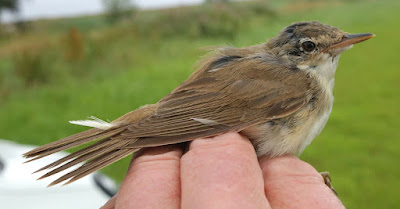The forecasts didn’t agree; now there’s a surprise, not. Maybe rain, maybe dry. So we decided to give it a go and I met up with Andy at 0700, far from the crack of dawn but best we could manage.
Earlier in the week on Wednesday, Thursday and Friday I had seen small arrivals of the usual early birds, the species that breed fairly early and now more or less finished - Pied Wagtails and Meadow Pipits, plus small parties of Linnets numbering 10-20 individuals. Goldfinches at the feeders too, where many in their gingery brown plumage lacked the outnumbered colourful adults. Around the feeding station there is water that attracts the pipits and wagtails in their ever interesting autumnal plumage variations. Even hares stop by for a piece of the action.
Pied Wagtail
Meadow Pipit
Goldfinch
Meadow Pipit
Pied Wagtail
Woodpigeon
Pied Wagtail
In the week I saw the first autumnal returning Marsh Harrier, a male arriving from the east - dipping and diving, disappearing from view and then reappearing, eyes fixed on the ground in case of a slow moving target below.
He carried on flying west giving just a couple of chances for a picture before he was gone.
The route is one that the Marsh Harriers always take. We spot them with increasing regularity from July and into November, as they meet the sea wall and the ditches, dykes and farmland of North Fylde after their journey from north and/or east of Morecambe bay. The harriers proceed mainly west , sometimes directly south before taking an inland scenic mostly farmland route south so as to avoid flying over the conurbations of Fleetwood, Poulton le Fylde or Blackpool.
They are not looking for Big Macs, fish & chips or discarded sarnies, just fresh meat, a variety of prey including birds like Coot or Moorhen, frogs and mammals, especially rabbits.
Eventually the harriers will meet the coast again around the River Ribble, all the while avoiding Preston City.
Saturday morning ringing was uneventful, cool with spits & spots of rain and just 15 birds caught - 7 Goldfinch, 5 Reed Warbler, 2 Willow Warbler and 1 Sedge Warbler.
Reed Warbler
Sedge Warbler




















Hello Phil :=) Ha Ha! I'm sure some owls are thinking that when disturbed by gaupers.:=) Here it is sweltering, I'm exhausted with the heat but since I have been away from blogging for three months, I just came by to say hello, and I'm back blogging again.
ReplyDeleteAll the best
Sonjia.
It's so refreshing to read your field reports! I know it's still summer, but one can "sense" that bird populations are packing their little suitcases and making travel reservations for the annual migration flight.
ReplyDeleteAround here, our first hints are the gangs of Swallow-tailed Kites which are forming in anticipation of launching towards Argentina in a couple of weeks. I recently read the mature birds leave first followed by this year's offspring.
We hope to return to the swamps and forests soon. Gini liked the hospital food so much she remained there a whole week. Lovely view from her room but she insists she prefers the lakes and wetlands. Go figure.
Count us in the group of "rather be birding" as well.
All the best.
Fabulous photos and interesting info on the Harrier. Everything here is on a go slow, temperatures yesterday at 39C felt like 41C. No let up at all in the next fortnight so it seems.. So much to do and no energy despite the fact I prefer the heat to the cold!
ReplyDeleteTake care, Diane